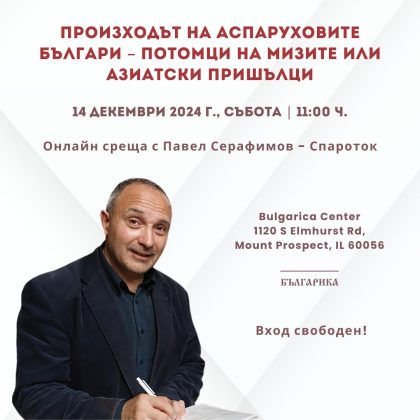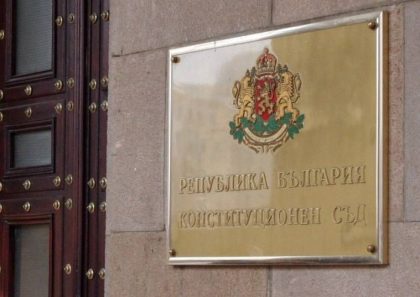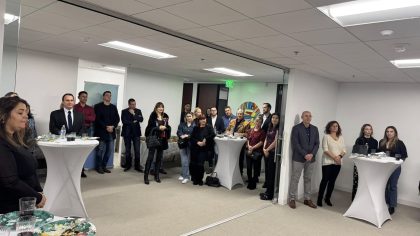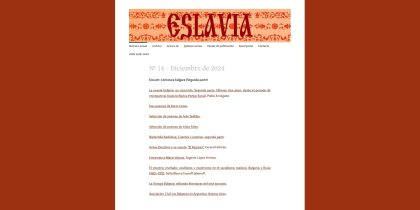Prof. Ph. D. Nichola Charakchiev *
Bulgarian Federation genealogical „genealogy“
(Subject to Development – Update November 18, 2011)
Intensive development of science in the world also benefit the development of genealogy. In this connection, will make a first attempt at a new classification in the development stage of the science of reproduction.
The first stage of genealogy is the legal step is the second – bit, and the third – the genetic stage. The newest phase, which recently emerged, is the fourth, called the working name of the author – Genealogy synthesis. The first three steps analyze the situation (blood kinship line) of the individual and the fourth stage may be used in a synthesis of members of the genus. The first and second stage, according to classical methods of genealogy and the third, fourth and subsequent stages are driven by methodological genetic genealogy.
Classical genealogy
Classical genealogy establish and document the social status of individuals (date and place of birth, marriage, divorce and death documents survivors’ financial status, education, personal identification number stored genetic memory, social realization of specific members of the genus and t . etc.) originating from one ancestor. Some historical sources of information on classical genealogy contains information for both legal and domestic stage. This most commonly occurs in the genealogies of the distant past. According to L’Histoire et ses méthodes. Encyclopedie de la pléiade. Paris, 1961 and Durye, P. La Généalogie. Paris, 1985 at the old genealogy document may be considered the Bible and genealogy of Jesus Christ in the New Testament and the Gospel of Matthew the first century. There is a small number of dynastic genealogy in the western Middle Ages (such as manuscripts and early printed editions). One of the oldest genealogical book is described Herold, Jean. Généalogies figurées de la Maison royale de France et d’autres maisons illustres. Bâle. 1556.
Classical genealogy in Bulgaria used to establish the genealogy of a person from the current time to 200 (or more) years back. The conditions of Bulgaria cognitive process is dependent on the stored written, physical and oral historical sources (information sources) that due to historical vicissitudes of the state are very scarce for the period obhvashtash early nineteenth century ago.
First Stage – legal
In historical Roman law for the first time regulates legal relations in blood kinship community. In this sense, it is considered the source of classical genealogy. In Roman law refers to „father of the families“ – „pater familias“. These are the sons and daughters of the pater familias, his wife, daughters, grandsons and granddaughters. Daughters, married, are not included in the Roman surname of his father.
The first written evidence in Bulgaria’s entry in the records of persons in the Bulgarian lands, where each of them is indicated by name, occupation and place of residence, dates from 1850, this year on probation may be considered the beginning of classical Bulgarian genealogy. Regular Metric keeping books of Christian churches in Bulgaria started in 1862 They have recorded births, marriages and deaths.
Only a few years after the liberation of Bulgaria from Ottoman rule, by the Decree of 10.12.1880 year, the „Act Notice births, marriages and deaths (ZZRZHU).“ Under this law, civil status registers are led by parish priests, imams and hahamite who are required to indicate in a special register any birth, marriage and death. Act of 1880 the first regulations governing the names of civilians.
Real effect of ZZRZHU reflected only after the introduction of official registers of civil status in 1892, when assigned to the municipal councils work on registration of the population. Law on civil registers of birth, marriage and death of 1892 with effect from 1.01.1893 year. Factual records began to be kept after the promulgation of „Regulations for Notice births, marriages and deaths“ from 24.03.1893 year.
The earliest manuscripts of dynastic genealogical information in Bulgaria can be considered „Nomocanon the late fourteenth century, copied from the monk Simeon“ and „Script pop Puncho of Mokresh, Lom, from 1796.“ There is also a „genealogy of Gradeshki priests’ alleged home with around the fourteenth century, with perhaps a kinship ties and the author of this material?
Phase Two – bit
Bit stage sets, and bits of the individual people of a country and a family and patriotic contribution. At this stage, a so-called „Family History“, consisting of a description of the genus and displays generic schemes, called „family trees“.
Methodological materials for residential stage in Bulgaria are explained in detail and published in the journal „genealogy – Genealogia“, issued by the Bulgarian Federation genealogical „genealogy“ www.genealogy-bg.com, as well as www.EuroChicago.com. Copies of the magazine (including the U.S.) you can order through [email protected]. Practical methods of genealogical author of 1980 was developed in the material „Bulgarian generic links’, which is updated periodically. So far no data are available, when it launched the residential stage in Bulgaria and abroad.
For a start bit of genealogy stage in Bulgaria can be considered „genealogy of pop Yovcho Popnikolov from Tryavna,“ which covers the ancestors and descendants in the period from 1650 to 1865.
Genetic Genealogy
Genetic genealogy establish and document the genetic resources of the individual (biological inheritance etnoharakteristiki the individual). Used to establish the genealogy of a person (from current time) to 10,000 to 70,000 years back in time. Powerful tool for establishing kinship ties are DNA analysis. DNA analysis can be found:
– Identification of a specific person;
– Degree of relatedness between individuals – brother, sister, father, mother, cousins, etc.
– Determination of the origin and migration routes of Homo sapiens sapiens, appeared 75,000 years ago in Africa in what is now Ethiopia, etc.
Practical commercialization of genetic genealogy starting from 1988 year, when National Geographic (National Geographic) creates Genopraphic Project and began to collect data on the origin and migration of peoples. In April 2000 Bennett Greenspan founded the company Family Tree DNA. Since 2007, one of the leading company in the field of genetic genealogy e 23andMe.com, and one of the founders of this project is the genetic Vodzhitski Annie, wife of Google founder Sergey Brin. Of particular interest is 23andMe.com FamilyTreeDNA.com and product Relative Finder (Finder relatives). The author of this material has research in both companies. Relative Finder product of 23andMe.com the end of 2011 showed more than 120 relatives of the author in the range of 10 to 90% of matches in the genome, in studies 1 million „base“ of the genome. (For reference, the complete human genome comprises 3 billion and 300 million „base“). In 2005, establishes an international association of genetic genealogists – The International Society of Genetic Genealogy (ISOGG). Director of the Association is Katherine Borges.
To start the genetic genealogy in Bulgaria can be considered an article of Prof. Dr. Antoinette Zapryanova in the journal „Genealogy“ Issue 1 of 2008 entitled „Genealogy and genetic genealogy, or where records are silent“
Phase Three – genetic analysis
Genetic analysis is currently under development and continues to improve. Learning process is dependent on the number of „bases“ that are known to the organization conducting the DNA analysis.
Genetic analysis, currently and in future developments may include the following areas:
1. Genetic Strand concept.
– Strategy of genetic genealogy.
– Opportunities to obtain information about the software (information about our own DNA), managing our personal lives.
– Algorithm of the „Planning and management of our lives through knowledge of our own software.“
– The first cell (embryo) – a program for learning.
– DNA invest (or invest in some DNA).
– Relationship to the genealogy of concepts Avatar, Cyborg.
and others.
2. Health Department
– Personalized medicine.
– Health status and disposition.
– Gene information on specific diseases.
– Gene therapy, psychology, pharmacy, and other sports.
3. Strand Life
– Establish migratory origin of the individual through Y-DNA and mtDNA test.
– Establishment of an individual belonging to the communities through atDNA test.
– Research and genotype results for the Bulgarians.
– Gene Information for peer compatibility.
– Gene selection of marriage.
– Definition of family ties through the „Finder relatives’ DNA test.
4. Genetically investment destination
– Investing in „Quality DNA“.
– Study the balance of the terms „nature“ or „education“?
– Algorithm of the „Planning and management of our lives.“
– Algorithm before marriage and after marriage program.
– Algorithm for connecting a wedding program.
– Gene consultant.
–
5. Department genomes
– The genome of Homo Neanderthals.
– The genome of Homo Denisovans.
– The original and basic genome of Homo Sapiens Sapiens.
– The genome of alien beings.
– The genome of God.
Stage Four – genealogy synthesis
Genealogical synthesis is in its pioneering stage. Can be predicted, recommended the following steps as a concept of genealogical synthesis proposed by author:
– Planning genealogy synthesis of two parents;
– Planning genealogy synthesis by more than two parents;
– Planning genealogy synthesis with guaranteed parameters;
– Guaranteed genealogical configuration parameters of the individual.
To start a genealogical synthesis in Bulgaria can be accepted this paper, first published in www.EuroChicago.com on July 7, 2011 (https://www.eurochicago.com/2011/07/etapi-v-genealogiya- opit-za-klasifikatsiya /).
Fifth stage – „synthesizer“?
At the time of publication of this material originated the idea for the formation of the next fifth step in genealogy. Formed the hypothesis for a „(quasi) synthesizer“. The term „synthesizer“ e collectively for over a function, for example – Nature, God, God, Intelligent Design, maker of algorithms and other not yet established concepts. Interest are the problems:
– Define the function of the „synthesizer“.
– Genome „synthesizer“.
– What regulates the „synthesizer“ through the love?
– Can the „synthesizer“ jealous?
– Can you lie „synthesizer“
– Other hypothetical problems.
To start the summary term „synthesizer“ in the world can accept the author’s article „Who created God“, which was first published in www.EuroChicago.com on September 18, 2010 (http://www.eurochicago .com/2010/09/koy-e-sazdal-bog-2 /).
Sixth stage??
Expect six steps? Our forecast of fantasy and science is limited. Whether this is predetermined by the „synthesizer“?
Conclusion
Perhaps the above steps in genealogy available for the first time in world science and we expect constructive criticism by the leading specialists in this field.
*
Thanks. The author thanks Professor Antoinette Zapryanova for review, recommendations and numerous additions to this material.
Note. The problems described in stage three, fourth and fifth can be developed in detail in the presence of relevant government institutions, corporations, investors and sponsors. Address [email protected].
* The author is a member of the editorial board of the magazine „genealogy / Genealogia“.
File: EG-OK-12






